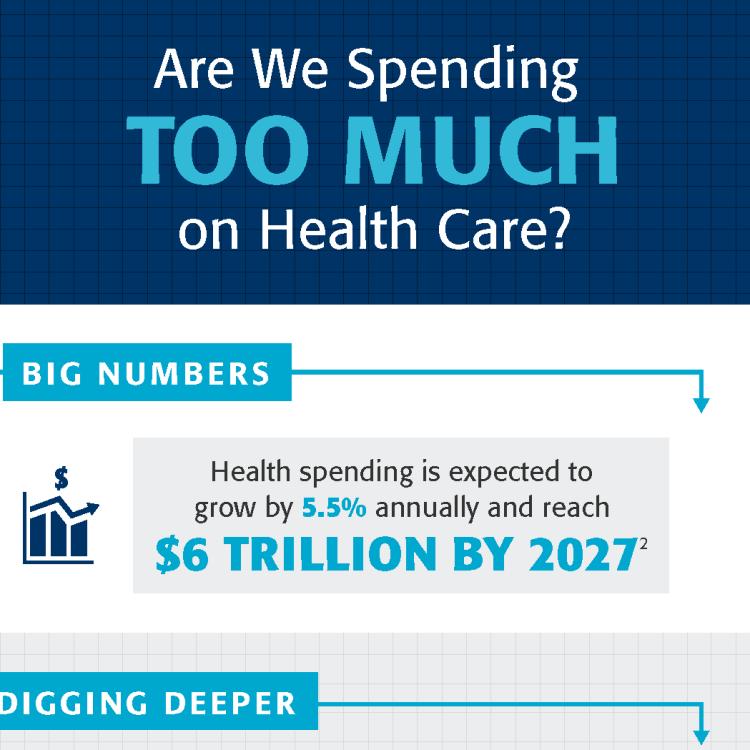What do we know about health spending in the U.S.?
By 2028, health care spending in the United States is expected to comprise nearly 20% of the gross domestic product (GDP), according to the Centers for Medicare & Medicaid Services, up from about 13% of GDP in the year 2000.
Accompanying this decades-long increase is a public debate about health spending that presupposes that we are currently spending too much, or that the United States is heading in that direction. Upon closer examination, the data often tell us something different.
What’s driving health care spending?
This question often leads stakeholders to focus on sector level spending -- biopharmaceuticals, hospitals, providers, procedures, devices, long-term care facilities, etc. – to determine the primary drivers.
Data from the Kaiser Family Foundation offers an interesting look at some of the primary drivers of U.S. spending and comparing it to what happens in countries with similar economies.
Here’s what their study, based on 2018 figures, found:
- Outpatient and inpatient services: in the U.S, $6,624 per person, other countries $2,718 per person.
- Drug spending: In the U.S. an average of $1,397 per person. Other countries, $884 per person.
Adopting a European model to drug price regulation could save about $500 per person, on average. Meanwhile, inpatient and outpatient expenses – basically, what we spend at the hospital and doctor’s office – are nearly $4,000 more per person in the U.S. than they are in other countries.
What the Debate Needs: An Understanding of the Key Questions and Data
Policymakers and other stakeholders need to ask two key questions: how much should the U.S. spend on health care and how should health care spending be allocated across the various sectors of the health care system?
Answering that question is not simple. That’s because one number or data point doesn’t always tell the full story. Often, it’s necessary to dig deeper into the details to understand when – or if – numbers can be directly compared, as well as the implications of specific numbers for patients and other stakeholders, such as taking disease burden and prevalence into account. All research data have limitations, and failing to pay heed to those limitations can not only mislead or confuse, but – even worse – send policy-makers chasing the wrong solution.
Health spending decisions should be patient-centered. To achieve that, decision-makers must consider how spending will impact outcomes that are important to patients and society.
Common Areas of Misinterpretation
Costs, without context: In many cases, people are often looking at an incomplete picture of data, assessing cost, without data on the value of health interventions or adjusting for changes in environmental factors like disease burden and population growth.

What's Been the Bang for the Buck?
Learn about the cost-effectiveness of health care spending across selected conditions in the U.S.
Drug spending: As health care stakeholders continue complex discussions on health care spending in the United States, estimates of drug spending are often central to the public policy debate on how to manage that spending. Different sources cite prescription drug spending estimates as anywhere between 9.8% and 23.3% of overall health care spending. If stakeholders are unable to agree on a number, they are unable to even begin to agree on a policy. Understanding why there is wide variation in drug spending estimates, driven primarily by methodologic differences, is an important step in seeking solutions.
Drug list price vs. net price: The list price is the asking price; net price is what is actually paid, once discounts, rebates and other factors throughout the complex health care supply chain are taken into account. Research studies often use list prices as a way to compare changes in drug prices each year, but they do not accurately reflect costs to the health care system.
U.S. drug spending vs. ex-U.S. spending: There are numerous studies showing that the United States spends more on health care than other countries because of higher prices, higher health care salaries and administrative costs. These studies often rely on data from the Organisation for Economic Co-operation and Development (OECD) and underscores the benefits and challenges of the dataset and making cross-country comparisons.
Learn more about the challenges of making cross-country comparisons from the analysis published in the Health Affairs blog.
There is a great deal of value in analyses, even with data limitations, but researchers and end-users must be careful not to make assumptions beyond what the data can tell us. It’s also important to consider the limitations of the underlying data and the idiosyncrasies of the U.S. health care system when drawing conclusions and developing policy proposals based on results from conjecture or inference rather than from actual data.



